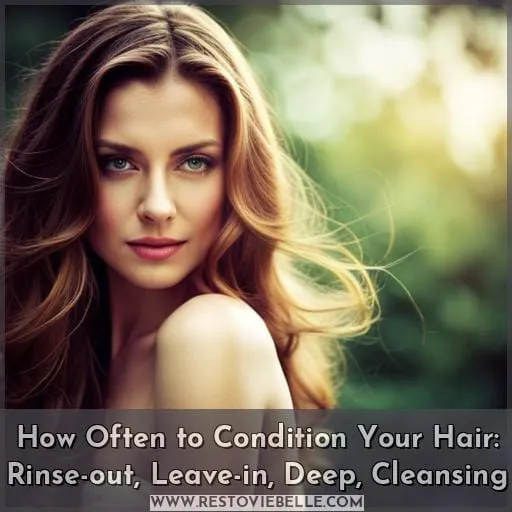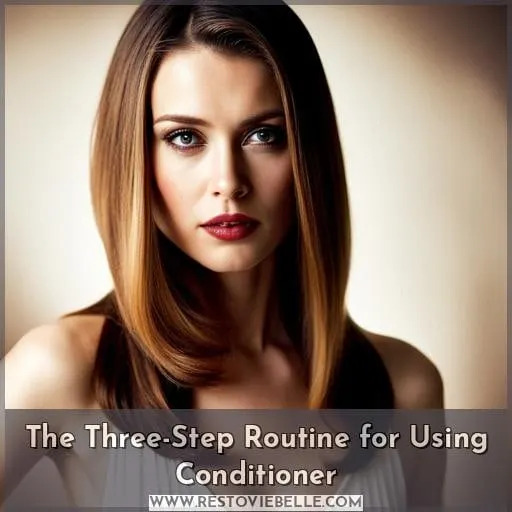This site is supported by our readers. We may earn a commission, at no cost to you, if you purchase through links.
 Curious about how often you should condition your hair? It’s an important part of any hair care routine, but the frequency and type of conditioning you use depend on both your unique hair type and what kind of products are best for it.
Curious about how often you should condition your hair? It’s an important part of any hair care routine, but the frequency and type of conditioning you use depend on both your unique hair type and what kind of products are best for it.
Fortunately, understanding the basics can help keep your locks looking their very best. From rinse-out to leave-in to deep treatments, here’s a look at when each one is most effective — so that you can determine just how often to condition your tresses for optimum results.
Table Of Contents
Key Takeaways
- Rinse-out conditioner is recommended weekly for moisture balance.
- Deep conditioning is advised once a month for repair.
- Leave-in conditioner is suitable for all hair types and should be used weekly.
- Cleansing conditioner is recommended for fine or oily hair and can be used daily or every other day.
How Often Should You Condition Your Hair?
When it comes to conditioning your hair, you have a few options. The American Academy of Dermatology recommends rinse-out conditioner for all hair types, but less frequently for oily or fine hair. For dry, coarse, curly, or color-treated hair, deep conditioning once a month can be beneficial.
Leave-in conditioners are best used weekly, or more often for very damaged or dry hair. Cleansing conditioners can be used daily or every other day as an alternative option, especially for fine or oily hair.
Rinse-out Conditioner
You should use a rinse-out conditioner weekly to maintain moisture balance and repair damage. Factors like hair type, hydration needs, and conditioning techniques affect the duration of application. Determine your hair’s specific requirements for optimal results: moisturize after chemical treatments or replenish dry strands; avoid over-conditioning with lightweight products; co-wash coarse or curly tresses if needed.
Leave-in Conditioner
For maximum hydration, applying a leave-in conditioner weekly helps replenish moisture and repair heat damage. Its lightweight formula is suitable for all hair types, but especially beneficial to dry, coarse or color-treated locks.
Deep Conditioner
Feel the nourishing power of a deep conditioner once a month to restore your tresses. It’s packed with ingredients that repair and hydrate hair, leaving it looking healthy and moisturized. Apply according to instructions for maximum benefits; use just enough product but not too much.
Hair will look smoother and stronger with improved shine! Enjoy the added bonus of protection from styling damage as deep conditioning locks in moisture and seals split ends for increased elasticity and flexibility.
Cleansing Conditioner
Rejuvenate your tresses with a cleansing conditioner—it’ll cleanse and nourish them in one go! It’s perfect for fine or oily hair, used daily or every other day. Choose the right type of product to maximize its benefits: use lightweight products on thinner hair and heavier ones for dry, brittle strands.
Remember to adjust your routine based on how often you shampoo as well as check signs of overusing—like weighed-down locks—so that you don’t damage your hair further.
Benefits of Using Conditioner
Are you looking for ways to improve the health and appearance of your hair? Conditioning can help! Not only does it increase moisture retention, restore elasticity, and reduce frizz, but it also reduces damage done by heat styling.
With a few simple adjustments to your routine based on the type of conditioner used and hair needs, conditioning can make all the difference in achieving beautiful locks.
Improved moisture retention
By regularly conditioning your locks, you can lock in much-needed moisture and keep them looking healthy. Effective hydration techniques help to retain humidity while controlling hair porosity. Plus, scalp health is improved with consistent conditioning – overnight treatments are great for deeper nourishment! To ensure the best results, use a conditioner that fits your hair texture and be sure to avoid common mistakes like over-conditioning or under-conditioning; consistency will lead to optimal hair health.
Restores hair elasticity
Conditioning your mane with the right products can help restore its natural elasticity, so you can rock bouncy styles that stay put all day long! Hair elasticity benefits vary between hair types and include improved texture, increased manageability, and flexibility.
For dry or damaged hair, deep conditioning treatments are recommended once a month for best results. Products containing oils like jojoba oil or coconut oil may also help improve elasticity in different hair types by replenishing moisture lost through heat styling tools.
To maintain healthy-looking locks with optimal levels of elasticity, use conditioners designed specifically for your particular type of tresses every time you shampoo it! This will add shine while protecting against split-ends caused by excessive dryness and breakage due to over-conditioning.
With proper care using quality products tailored to meet the needs of each individual’s unique style.
Reduces frizz and damage
You can reduce frizz and damage to your hair by using conditioners that are formulated for your specific hair type. Expert advice recommends adjusting conditioning frequency based on the texture, thickness, and oiliness of your hair.
Heavy-duty formulas will help combat dryness or heat damage, while lightweight ones won’t weigh down thin tresses.
Depending on the conditioner you use, apply it from ears down instead of directly onto the scalp to prevent over-conditioning, which can make strands too oily or weighed down. Leave-in treatments should be used weekly if needed, but less frequently for finer locks.
Deep conditioning is recommended once a month for severely damaged or dry manes.
Follow these tips to keep frizz under control and protect against further damage while keeping healthy shine intact!
The Three-Step Routine for Using Conditioner
Unlock the secret to a nourished and beautiful mane with a simple three-step conditioning routine.
- Hydrate your hair after shampooing. Applying conditioner locks in moisture by closing off cuticles on strands. It also helps improve elasticity, which prevents breakage and damage from heat styling or environmental stressors.
- Choose the right type of product. Depending on your individual needs, you may want to try different types of conditioners, including rinse-outs, leave-ins, and deep treatments such as masks or hot oil treatments for extra hydration. Fine or oily hair will usually benefit from lighter products, while curly, dry, or color-treated tresses need heavier formulas to lock in moisture.
- Adjust according to current conditions. Pay attention not only when choosing products but also when using them, depending on if you have recently been exposed to too much sun/heat/chemicals, etc., that might require more frequent use than usual. Alternatively, if the scalp becomes excessively oily, reduce usage accordingly.
By following these steps regularly, maintaining strong, glossy tresses is attainable without overloading them with unneeded chemicals! Start today towards healthier-looking, better-feeling locks!
Common Mistakes to Avoid When Using Conditioner
Be sure to avoid over-conditioning your hair, as this can lead to it becoming weighed down and oily. It’s important for you to listen carefully and adjust your conditioning routine accordingly if you notice the texture of your hair changing.
Common mistakes include applying too much conditioner or using one that is meant for a different type of hair than yours. Pay attention when selecting a product, as some are better suited for dry or coarse locks while others are designed specifically with thinning strands in mind.
Additionally, be mindful not to use conditioners on the scalp itself – instead, apply from ears down along the length of each strand so that hydration is achieved without weighing it down unnecessarily.
If properly applied according to individual needs and preferences, conditioners can help nourish damaged strands by providing much-needed nutrients, which will reduce breakage caused by styling products or harsh environmental factors like UV rays or pollutants in air quality.
Furthermore, ensure adequate time between washes so that natural oils produced by the scalp do their job protecting follicles from damage due to extreme heat exposure during blow-drying sessions.
Tips for Deep Conditioning Your Hair
It’s important to give your hair the nourishment it needs, and deep conditioning is a great way to do that. Deep conditioners are rich in proteins and oils that penetrate deeper into the hair cuticle than regular conditioners, which helps repair damage from styling products or heat treatments.
- Choose a shampoo specifically designed for prepping your hair before using a deep conditioner.
- Use an applicator brush when applying the product so you can be sure you’re evenly coating all areas of your strands with an even layer.
- Leave on for at least 15 minutes (or longer if needed). This gives time for ingredients to deeply penetrate each strand and provide optimal benefits such as increased elasticity maintenance, moisture restoration, improved strength, and shine.
- Rinse thoroughly with cool water after treatment as hot water can cause protein loss from overprocessing and drying out strands.
- To maintain lasting results, use once per week or more depending on how dry or damaged your locks may be.
Following these steps will help keep dryness at bay while providing intensive hydration and reparation through powerful active ingredients found in professional-grade therapeutic masks!
Personalizing Your Hair Care Routine
Personalize your hair care routine based on the type and condition of your locks. This includes customizing recommendations around shampooing, conditioning frequency, product selection, and more.
Start by doing a hair texture analysis to assess what kind of moisture balance you need for optimal scalp health. Depending on the results, you may opt for lighter or heavier products as well as adjust how often you use them up or down accordingly.
When it comes to shampooing less often – which is beneficial for many types of hair – pay careful attention to dirt accumulation that can cause knots in strands if not properly removed after exercise or other activities where sweat plays a part.
You should also factor in any chemical treatments like coloring when determining personalizing needs since those require special care beyond just avoiding harsh sulfate-based shampoos/conditioners.
Conclusion
You’ve now discovered the secret to beautiful, healthy hair: conditioning! Knowing how often to condition your hair is key to avoiding over-conditioning, under-conditioning, and all the problems that come with them.
Depending on your hair type and needs, rinse-out conditioners are recommended a few times per week. Leave-in conditioners can be used weekly, while deep conditioners should be used monthly.
The benefits of using conditioner are numerous, from improved moisture retention to reduced frizz and damage. To get the best out of your conditioning routine, use a three-step process: apply conditioner from ears down, listen to your hair, and adjust your routine as needed.
With the right conditioning routine, you’ll have smooth, shiny, and beautiful hair in no time!











